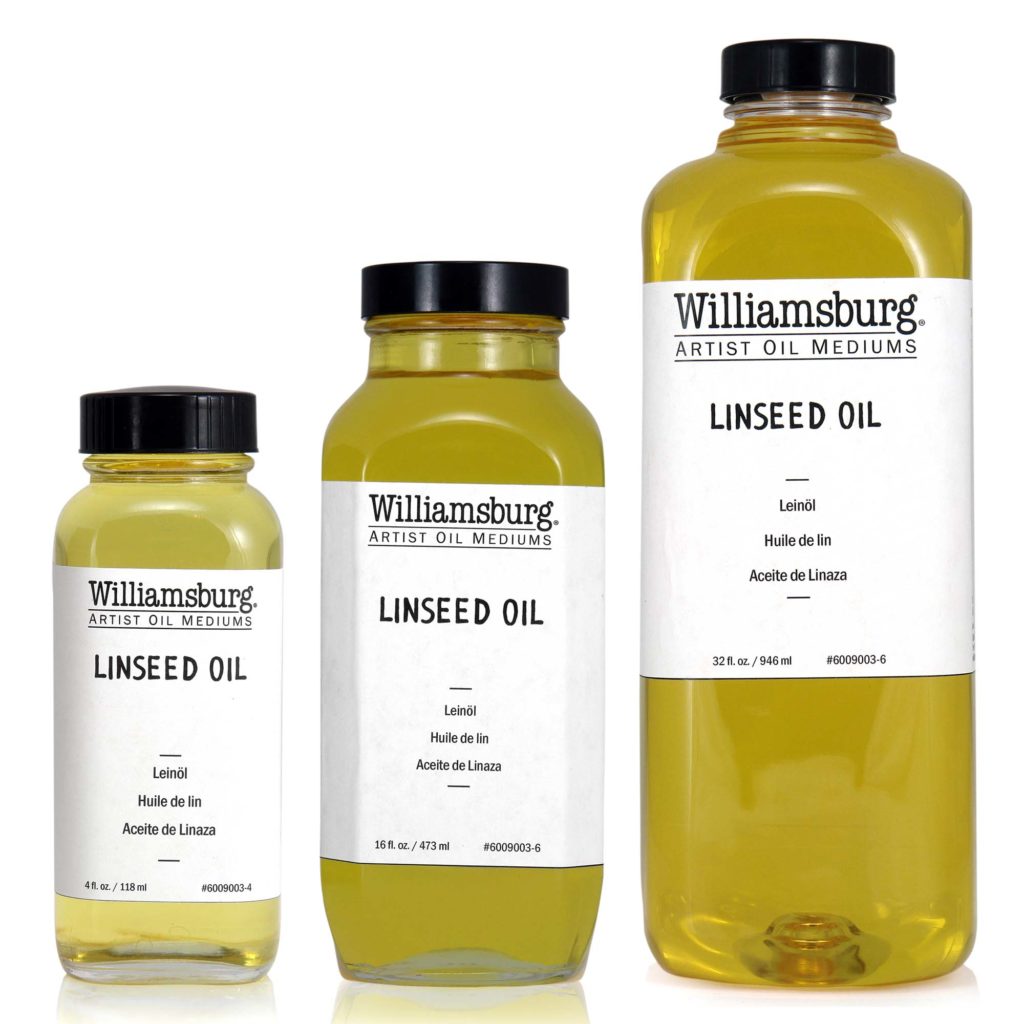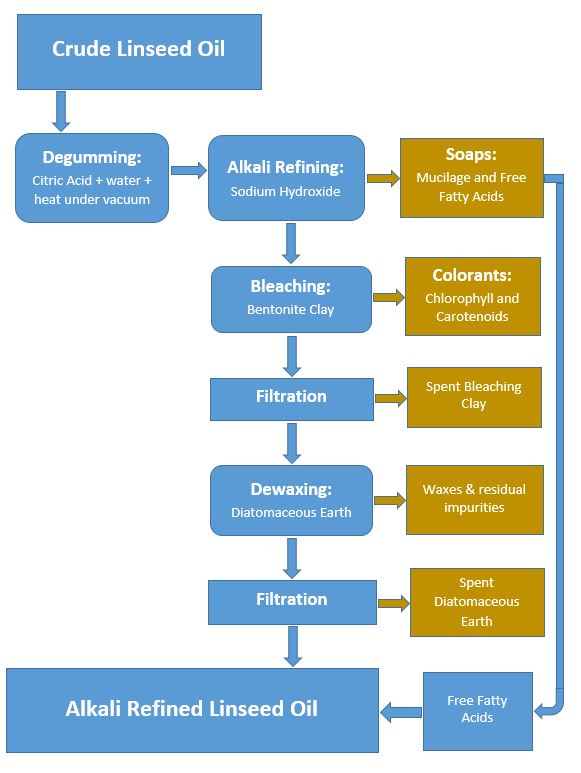Linseed oil comes from flax seeds which are harvested from the same flax plant that produces the fibers used to make linen. Artists have been using linseed oil for centuries to make paints, mediums and varnishes. It is widely used today, not only in artist materials, but also for a wide range of industrial applications and as a dietary supplement. Linseed oil dries relatively fast and produces a durable, flexible paint film. The term alkali refined, when used in relation to oils, refers to the way the oil is extracted from the seed and subsequently clarified. This article will describe the alkali refining process and how it produces a high quality oil for use in artist paints and mediums. Williamsburg Handmade Oil Colors uses alkali refined linseed oil in all of our paints, except for our twelve safflower oil colors.
Extraction
All linseed oil starts with flax seeds that are harvested and cleaned. Seeds used to produce alkali refined oil are then optionally toasted or dried, then rolled. Putting the seed through rollers cracks the tough outer shell and turns the seed into a coarse meal. The meal is then heated and hydrated with steam to prepare it for pressing. Adding heat and moisture to the pressing process increases the yield of oil compared to just using pressure to crush the seeds. The drawback from heating and hydrating during pressing, is that the oil contains more plant matter and impurities that have to be removed through refining. After heat pressing, the remaining oil in the meal can be removed through solvent extraction using hexane. The solvent is then separated from the oil through distillation and reclaimed for future use.
Removal of Impurities
The crude oil then goes through a number of refining processes to remove plant matter, colorants, proteins, waxes, and other impurities to make a clean, stable binder for oil painting and other applications. Acid washing is the first step in this process. Sometimes called degumming, this step helps to remove mucilage, a thick sticky substance, by mixing the oil with water and citric acid under a vacuum at a temperature around 80⁰ C / 180⁰ F (1). These conditions hydrate free fatty acids called phospholipids that are contained within the mucilage. This process links the phospholipids (and the mucilage) to the water and drags them out of the oil in the form of a sludge.
Alkali Refining
An alkaline solution, such as a dilute, aqueous sodium hydroxide, is then added to the tank. This higher PH solution neutralizes the citric acid and forms soaps around the mucilage and remaining free fatty acids. The soaps and the impurities they contain, are then removed through centrifuging. Alkali refining is a very effective method for capturing mucilage and other impurities, but the drawback is that it flushes free fatty acids from the oil. While reducing the number of free fatty acids is beneficial to create a clear, light colored oil that yellows less over time, it is necessary to have a certain amount of free fatty acids in the oil to improve wetting of pigments and flexibility of the paint film. In order to facilitate the proper number of free fatty acids in alkali refined linseed oil, manufacturers recapture and clean the free fatty acids removed during degumming, and then add them back into the oil in varying amounts depending on the desired end product. However, before that step occurs, the oil is bleached and put through filtration.
Bleaching and Final Filtering
Bleaching reduces pigments from the oil such as carotenoids and chlorophyll, in addition to residual “phosphatides, soaps, traces of metals, oxidative products and proteins” (Fediol). These impurities are removed through absorption into a special acid-treated bentonite clay that is mixed into the oil and activated by heat. After it absorbs all these impurities, the spent bentonite clay is then filtered out of the oil and recycled. The almost fully refined oil is then dewaxed either through a low-temperature winterization or by passing it through diatomaceous earth. Diatomaceous earth is a natural substance comprised of the remains of silica-based aquatic organisms. This would be similar to passing the oil through exceedingly fine sand, but the shapes and sizes of the diatomaceous earth particles are variable and therefore more effective at capturing impurities and waxes. The oil is then passed through an advanced filtering system under pressure to remove any residual impurities and spent diatomaceous earth. The final step is to adjust the acid values by adding in free fatty acids to meet the needs of the end user.
Benefits and Uses
Alkali refined linseed oil can be used effectively to make oil paint and oil painting mediums. Traditionally, cold pressed oils have been considered more effective for grinding paint because they have a higher acid number which tends to coat pigments more effectively than oils with lower acid numbers. Fortunately, today’s alkali refined oils are available with a variety of acid numbers to optimize wetting of pigment, drying, and yellowing. Alkali refining linseed oil produces a light, straw-colored oil which is thought to yellow less over time than linseed oils that have not been refined. This is due to the reduced number of free fatty acids and plant matter in the oil. Alkali refined oils are also consistent in their acid numbers, color, and cleanliness, making them a reliable choice for manufacturers. As dedicated as we are to alkali-refined linseed oil, we continue to test a variety of oils for dry time, film integrity and color stability. In addition, we have also explored more traditional refining methods since these might present advantages or qualities often overlooked or lost in the drive for more efficient, industrial processes. Ultimately, Williamsburg Handmade Oil Colors is committed to exploring materials guided by science, research, and the insights from the conservation community. So, if another oil or method looks promising, we would not hesitate to consider that option. But, for now at least, alkali refined linseed oil remains the best choice.
If you have any questions or comments about this article or any other paint related topic, please feel free to contact our Materials Application Department at [email protected] or by calling 800-959-6543.
References:
- “Flaxseed (linum Usitatissimum L.) Oil Processing and Selected Products: A Review”, Trends in Food Science & Technology, Volume 43, issue 2, June 2015, pp. 162-177
http://www.sciencedirect.com/science/article/pii/S0924224415000473 - Fediol, Chemical Refining Flow Chart and Information: http://www.fediol.be/web/chemical+refining/1011306087/list1187970119/f1.html
- Fediol, Oilseed Crushing Flow Chart and Information: http://www.fediol.eu/web/oilseeds+crushing/1011306087/list1187970116/f1.html
- Fediol, Physical Refining Flow Chart and Information: http://www.fediol.be/web/physical+refining/1011306087/list1187970120/f1.html
- MITRA- Materials Information and Technical Resources for Artists/Resources/ Mediums and additives for painting: https://www.artcons.udel.edu/mitra/Documents/MITRA_Mediums_and_Additives.pdf



A question regarding acid degumming. Is it even needed to add the alkali solution if one would simply strain the upper part of degummed linseed + acid + water solution? The acid, be it from vinegar, or citric acid doesn’t mix with the oil, so after a while it should settle in the water, below the mucilage, right?
Hello Johannes,
Though I’m not an expert on oil refining by any means, that is the impression I get. I think adding the alkali solution helps to shock out the mucilage and other solids and also neutralizes the added acid. I am not sure how effective this process would be on a small scale or how long it would take for the emulsified oil to settle.
Greg